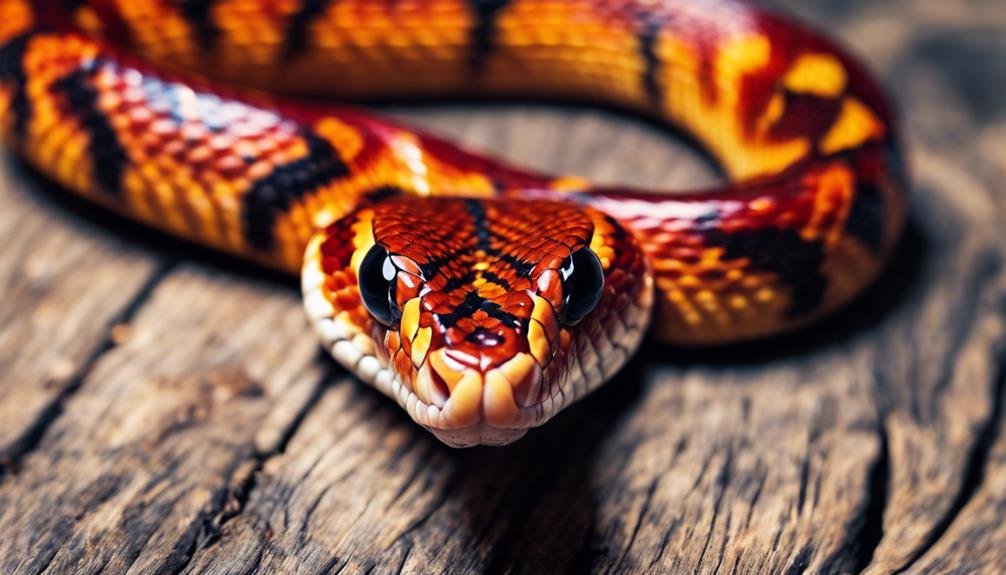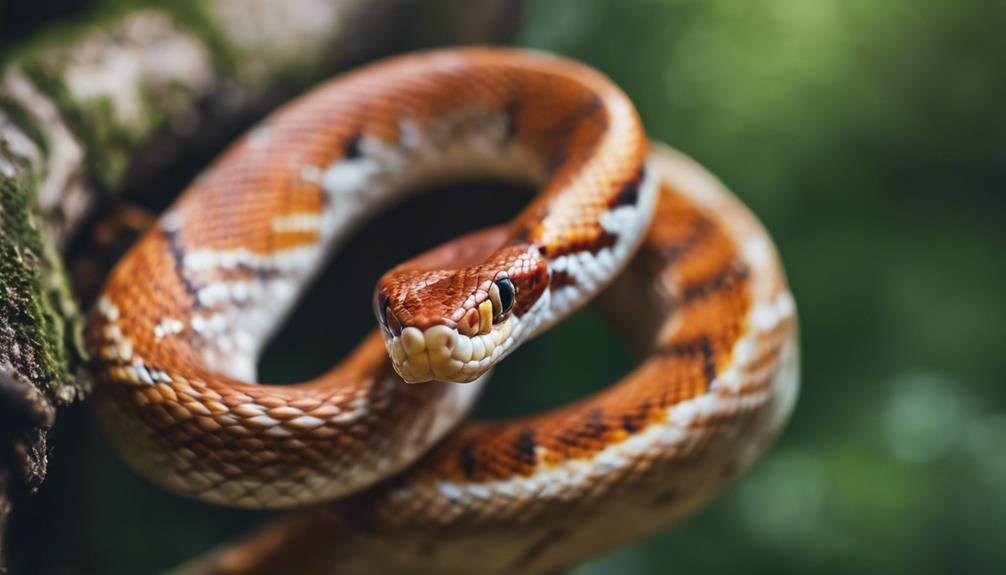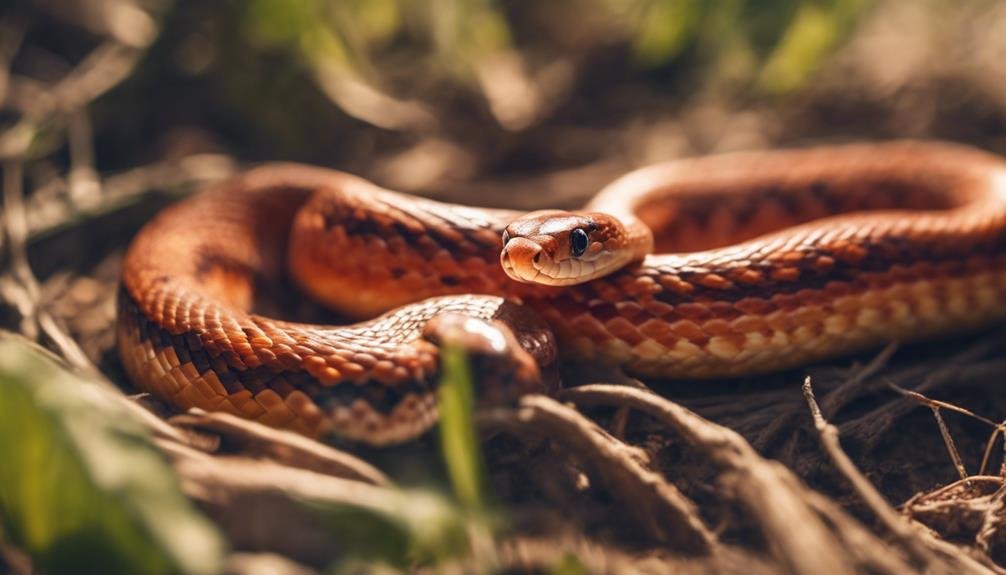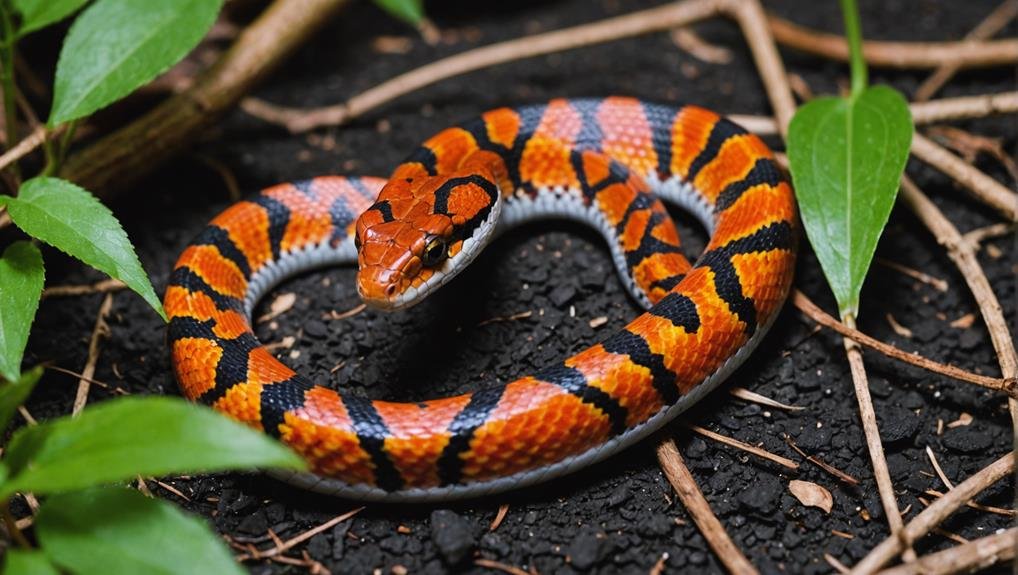When you think of corn snakes, their striking physical appearance probably comes first. With vivid reddish or orange blotches bordered in black, their scales resemble Indian corn. You might also notice the bold stripe running from behind their eyes to their jaws and the checkerboard pattern on their bellies. But there’s more to these snakes than just their looks. Found mainly in the Southeastern United States, corn snakes are known for their calm demeanor, making them a favorite among pet owners. Have you ever wondered how their behavior and diet contribute to their popularity? Let’s explore that next. Discover more about the Characteristics of Corn Snakes.
Key Takeaways
- Colorful scales with reddish or orange blotches edged in black, resembling Indian corn.
- Docile and tolerant temperament, making them popular pets.
- Primarily found in the Southeastern United States, it is adaptable to various habitats.
- Carnivores constrict prey, feeding on small mammals.
- Lifespan up to 20 years, with spring and early summer mating season.
Physical Appearance


Corn snakes captivate with colorful scales featuring reddish or orange blotches edged in black. You’ll notice that these snakes are often called ‘red rat snakes‘ due to their vibrant appearance. Their scales can remind you of brightly colored Indian corn, thanks to their diverse colors and patterns. One of a corn snake’s most striking features is its bold stripe extending from the back of the eye past the jaw, adding to its distinctive look.
As you examine their bellies, you’ll observe a unique checkerboard pattern of black and white markings. This pattern adds to the corn snake’s intricate design, making it a favorite among reptile enthusiasts. The orange scars on their bodies are eye-catching, contrasting starkly against their lighter background color. This contrast is further enhanced by the black borders around each blotch, emphasizing their detailed and vibrant appearance.
Corn snakes are highly variable in coloration and pattern, making each snake unique. Their scales reflect a combination of reds, oranges, and blacks, creating a stunning visual display that captures attention and admiration.
Habitat and Distribution
You’ll find these vibrant snakes primarily in the Southeastern United States, from Virginia to Florida and west to Louisiana. Corn snakes thrive in various habitats, taking advantage of overgrown fields, temperate broadleaf forests, and rocky hillsides. They’re also common in forest openings and around abandoned buildings. Their adaptability allows them to occupy diverse environments, extending their range from New Jersey to the Florida Keys and west to Utah.
Corn snakes are nocturnal, often emerging at night to hunt. During the day, they hide under loose tree bark, debris, or in caves. Their preference for areas rich in small rodents makes these habitats ideal. Unfortunately, habitat destruction poses a significant threat to their populations. The development of land for agriculture and urbanization reduces the availability of suitable environments, impacting their numbers.
Despite these challenges, corn snakes exhibit remarkable resilience. They can often be found in human-altered landscapes, such as abandoned buildings, where they continue to seek out their primary prey. Their reddish or orange blotches in these varied habitats provide excellent camouflage, helping them avoid predators while hunting.
Behavior and Temperament


Known for their docile nature, corn snakes make popular pets due to their tolerance for handling. They are renowned for their calm temperament, making them a favorite among reptile enthusiasts and beginner keepers. Their predictable behavior guarantees a stress-free experience for both the snake and the owner.
Corn snakes exhibit crepuscular behavior, meaning they’re most active at dusk and dawn. This natural activity pattern aligns with when their prey is also active. Despite their gentle demeanor, they are skilled escape artists. You’ll need to secure their enclosures properly to prevent any unexpected getaways.
| Behavior Aspect | Description |
|---|---|
| Docile Nature | Calm and tolerant, making them ideal for frequent handling. |
| Crepuscular Behavior | Most active at dusk and dawn, aligning with the activity of their prey. |
| Escape Artists | Skilled at escaping, requiring secure lids on their enclosures. |
Corn snakes may vibrate their tails when threatened as a defense mechanism to scare off predators. This harmless behavior mimics a rattlesnake’s sound and effectively deters threats. Understanding corn snake behavior helps you provide the best care, ensuring a happy and healthy pet.
Diet and Feeding
Understanding their diet and feeding habits is vital for guaranteeing your corn snake remains healthy and well-nourished. Corn snakes are carnivores that primarily feed on small mammals, with rodents being the most common prey species. In the wild, they may also consume reptiles and amphibians, and they’re known to raid bird nests for eggs, adding variety to their diet.
Corn snakes subdue their prey as constrictors, squeezing it before swallowing it whole. This natural hunting behavior should be considered when feeding them in captivity. Offering appropriately sized prey items is essential; too large a meal can cause health issues, while too small may leave them malnourished.
Young corn snakes need to be fed more frequently than their adult counterparts. Typically, you should offer food every 5-7 days for young corn snakes. As they grow and mature, the feeding schedule can be adjusted to every 7-10 days for adult corn snakes.
Maintaining a consistent feeding routine helps ensure your snake’s well-being and supports healthy growth. By understanding these dietary needs, you can provide a balanced diet that thrives your corn snake.
Reproduction and Lifespan


Corn snakes have fascinating reproductive habits and can enjoy long lifespans when properly cared for. Reproduction begins once they reach sexual maturity, which typically occurs between 18 and 36 months of age. The mating season usually occurs in the spring and early summer, making this a critical time for their reproductive cycle.
Female corn snakes can lay 12-24 egg clutches during this period. These eggs require an incubation period of about 60-65 days before they hatch. Ensuring the right temperature and humidity levels during this time is essential for successful hatching.
In captivity, corn snakes benefit from controlled environments and consistent care, allowing them to live up to 20 years or more. This considerable lifespan proves how well they can thrive with proper attention and habitat management.
If you’re considering breeding corn snakes, it’s important to understand their specific needs during the mating season and guarantee ideal conditions for their eggs during the incubation period.
Conclusion
Corn snakes make fantastic pets due to their striking appearance and calm demeanor. You’ll appreciate their fascinating patterns and colors and relatively easy care requirements.
They thrive in habitats mimicking their Southeastern U.S. origins and will impress you with their hunting skills. You’ll enjoy their company for up to 20 years or more with proper attention to their diet and environment.
Ready to welcome one into your home?
FAQs
1. What Is a Corn Snake’s Personality?
You’ll find corn snakes have a calm hatchling temperament. Their feeding habits are straightforward, and with regular handling tips, they’re quite docile. Understand their shedding cycles, habitat preferences, color morphs, size variations, breeding behavior, and sleep patterns.
2. What Is the Normal Behavior of a Corn Snake?
Corn snakes are crepuscular, showing daily activity at dusk and dawn. They need hiding spots to reduce stress. Their feeding habits align with their nocturnal activity. They climb, shed periodically, and exhibit seasonal behavior changes.
3. What Are 5 Characteristics of Snake?
Snakes have diverse color patterns, length variations, and a regular shedding process. Their feeding habits vary, and they prefer specific habitats. Key characteristics include lifespan ranges, breeding seasons, activity periods, and heat sensitivity.
4. Are Corn Snakes Aggressive?
Corn snakes aren’t typically aggressive. You can minimize stress with proper handling tips and by meeting their feeding habits, temperature requirements, and lighting needs. Paying attention to their shedding process and breeding season also helps.

